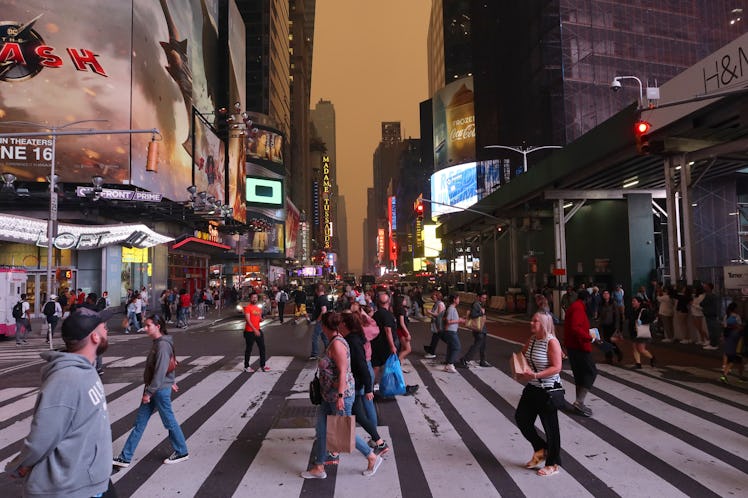This Common Pollutant Is As Bad For You As Secondhand Smoke
96% of Americans live in polluted areas. What does that mean for you?

We all know that secondhand smoke is dangerous, exposing anyone near a smoker to the same 7,000+ chemicals and 70 carcinogens found in cigarettes. Thanks in large part to aggressively successful anti-tobacco campaigns from organizations like Truth, studies show that smoking has decreased by almost 30% in men and nearly 40% in women, since 1990. But, as we learned this summer, there are other sources of dangerous smoke over which we have almost no individual control.
A recent report from the University of Chicago’s Energy Policy Institute found that polluted air is more harmful to our health than secondhand smoke — and that it shaves off an average of 2.3 years from life expectancies worldwide. The report found air pollution to be the “greatest external threat to human life expectancy on the planet,” with an impact more than three times greater than water pollution and five times greater than vehicle accidents on life expectancy.
And while you may think air pollution is more of a problem outside of the United States — the report did find that India, Bangladesh Nepal and Pakistan ranked highest in air pollution, with citizens losing close to five years of life, on average — conditions aren’t great in the U.S. either, despite tougher standards for air pollution than other nations.
The main difference is that much of our air pollution comes from wildfires, not industry. Twenty of the 30 most-polluted counties in the U.S. are in California, for example, where the pollution is attributable to the wildfires that plague the state every year.
Particulate air pollution is measured in microns. Particles smaller than 10 microns (PM10) can be inhaled and cause lung damage — this category includes things like dust and pollen. Air pollution from particles smaller than 2.5 microns (PM2.5) is a bit more sinister and includes pollution from the combustion of fossil fuels and wildfires. The PM2.5 standard for safety in the U.S. is currently 12µ/m³.
So which counties have it the worst? According to the University of Chicago report, those who live in California’s Central Valley now perpetually breathe air with pollution levels that exceed the PM2.5 standard. In just one county — Plumas County, in the Sierra Nevada — met the World Health Organizations’ guidelines for air quality, “residents would gain 2.1 years of life expectancy.” California may have it the worst, but Illinois and Indiana are not far behind, and the report estimates that an average resident in those two states is getting 4.8 to 6 months shaved off their life expectancy due to the air quality they breathe in daily.
Nationally, the rates are a little better — an average of 7.8µ/m³, which meets the U.S. standard but is higher than the WHO standard of 5µ/m³. Based on WHO data, 96% of Americans live in polluted areas.
Things are getting better, however. After the passage of the Clean Air Act in 1970, all but three counties in the continental U.S. have seen dramatic decreases in air pollution and, consequently, increases in life span. Since the implementation of air pollution standards included as part of the CAA, pollution has dropped 65% in the U.S. The only counties in the country that still see declines in life expectancy due to air pollution are Routt County in Colorado, Washoe County in Nevada and Klamath County in Oregon.
Based on WHO data, 96% of Americans live in polluted areas.
The report found, for example, that Pennsylvanians, on average, gained 2.5+ years of life expectancy due to air quality changes from 1970 to 2021. Meanwhile, New Yorkers gained about 2 years, and Texans about 1. But there’s still plenty of room for improvement: In almost every state in the U.S., life expectancy would be gained if air quality improved from current methods to the WHO standard.
This year, the Environmental Protection Agency suggested a change in acceptable levels of PM2.5 pollution — from 12µ/m³ to 9-10µ/m³. If that change is adopted, people living in the 40 U.S. counties that currently exceed the standard could gain a combined total of 3.2 million years of life.
“Americans breathe much cleaner air because of strong policies built on a foundation of data, information, and advocacy. Many of the most polluted countries today do not have that foundation in place,” wrote the report authors. “Our report of particulate pollution levels and their impact on life expectancy reveals a striking opportunity for policy, philanthropy, and development around the world to enhance the allow people to live longer and healthier lives.”
Air pollution hurts your heart and your lungs. And while you can’t control the environment, or wildfires, or unilaterally force the U.S. or your state or local government to adopt WHO standards for air quality, you can take a few actions to protect your family from some of the harms of air pollution. Make sure you replace the furnace filter in your HVAC system regularly, and consider investing in a HEPA air filter purifier or building a Corsi-Rosenthal Box to further lower indoor air pollution. N95 masks can also protect you from air pollution — particularly useful if the air quality is very bad that day.
This article was originally published on